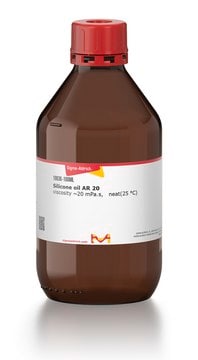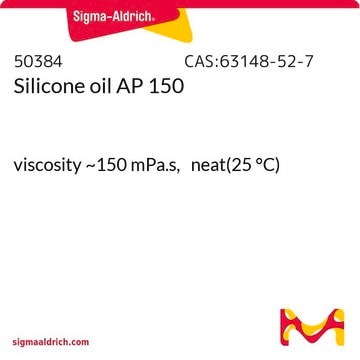175633
Silicone oil
high temperature
Synonym(s):
Poly(dimethylsiloxane-co-methylphenylsiloxane)
Sign Into View Organizational & Contract Pricing
All Photos(1)
About This Item
Linear Formula:
[Si(CH3)2O]x[Si(CH3)(C6H5)O]y
CAS Number:
MDL number:
UNSPSC Code:
12352100
PubChem Substance ID:
NACRES:
NA.21
Recommended Products
vapor pressure
<5 mmHg ( 25 °C)
Quality Level
parameter
−40-450 °F temp. range (−40-230 °C)
refractive index
n20/D 1.495
density
1.05 g/mL at 25 °C
SMILES string
C[Si](C)=O.C[Si](=O)c1ccccc1
InChI
1S/C7H8OSi.C2H6OSi/c1-9(8)7-5-3-2-4-6-7;1-4(2)3/h2-6H,1H3;1-2H3
InChI key
XWFOTLCDICUQTI-UHFFFAOYSA-N
Looking for similar products? Visit Product Comparison Guide
Related Categories
General description
Silicone oil is a highly viscous oil made up of poly(dimethylsiloxane-co-methylphenylsiloxane) chains.
Application
Silicone oil has been used as a medium component in containerless protein crystallization techniques which do not require contact with a solid surface. It was used as an oil bath during the synthesis of methyl 2-methylazulene-1-carboxylate.
Storage Class
10 - Combustible liquids
wgk_germany
WGK 3
flash_point_f
437.0 °F - closed cup
flash_point_c
225.00 °C - closed cup
ppe
Eyeshields, Gloves
Choose from one of the most recent versions:
Already Own This Product?
Find documentation for the products that you have recently purchased in the Document Library.
Customers Also Viewed
Hui-Ling Cao et al.
Acta crystallographica. Section D, Biological crystallography, 69(Pt 10), 1901-1910 (2013-10-09)
High-quality crystals are key to obtaining accurate three-dimensional structures of proteins using X-ray diffraction techniques. However, obtaining such protein crystals is often a challenge. Several containerless crystallization techniques have been reported to have the ability to improve crystal quality, but
Viscous liquid film flows over a periodic surface.
Trifonov YY.
International Journal of Multiphase Flow, 24(7), 1139-1161 (1999)
Colloidal ordering from phase separation in a liquid-crystalline continuous phase.
Loudet J-C, et al.
Nature, 407(6804), 611-613 (2000)
Jennifer Li et al.
The European journal of neuroscience, 34(12), 1983-1996 (2011-12-14)
Neuronal activity elicits metabolic and vascular responses, during which oxygen is first consumed and then supplied to the tissue via an increase in cerebral blood flow. Understanding the spatial and temporal dynamics of blood and tissue oxygen (To₂) responses following
Simon J Carter et al.
Xenobiotica; the fate of foreign compounds in biological systems, 50(4), 415-426 (2019-08-08)
Determine the inhibition mechanism through which cyclosporine inhibits the uptake and metabolism of atorvastatin in fresh rat hepatocytes using mechanistic models applied to data generated using a high throughput oil spin method.Atorvastatin was incubated in fresh rat hepatocytes (0.05-150 nmol/ml) with
Our team of scientists has experience in all areas of research including Life Science, Material Science, Chemical Synthesis, Chromatography, Analytical and many others.
Contact Technical Service






